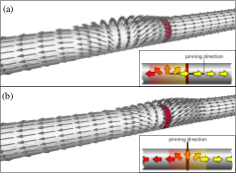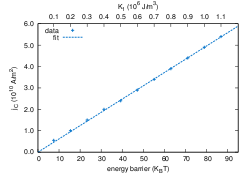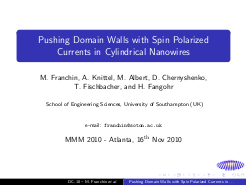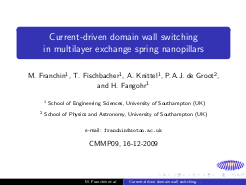Enhanced spin transfer torque effect for transverse domain walls in cylindrical nanowires
Matteo Franchin, Andreas Knittel, Maximilian Albert, Dmitri Chernyshenko, Thomas Fischbacher, Anil Prabhakar, and Hans Fangohr,
Enhanced spin transfer torque effect for transverse domain walls in cylindrical nanowires,
Physical Review B 84 094409 (9 pages) (2011)
Online: http://link.aps.org/doi/10.1103/PhysRevB.84.094409
Open access preprints available: pdf, also at http://arxiv.org/abs/1104.3010
Motivation
- It is important to study transverse domain walls in cylindrical
nanowires, as recent theoretical studies have been reporting
desirable properties for such systems, such as zero depinning current
and no walker breakdown,
- Moreover the cylindrical geometry is likely to play an important role
in the coming years. Indeed, a convenient way of densely filling
a given volume with nanowires is by engineering two dimensional
arrays of nanowires (basically drilling cylindrical holes in an insulating
film and filling it with ferromagnetic conductive material).
- It is important to understand how domain walls interact with potential barriers
(geometric barriers or other kinds of pinning centers), as these
are necessary in order to control the domain wall motion and make it more reliable
Summary
We study the field-driven and current-driven motion of transverse
domain walls through potential barriers in cylindrical nanowires
We study how the critical field or critical current density
required in order to push the domain wall through the barrier depends
on the direction of magnetization pinning in the barrier
We show that the critical current density is lowered drastically
for barriers which allow free rotation of the domain wall around its axis.
In particular, the critical current density required to traverse
a barrier with a given height in energy, can change by a factor ~130
depending on whether or not the domain wall is free to rotate
during its motion through the barrier.
We show that the efficiency of the energy pumping is related
to the spin torque being always directed opposite to the damping
term, leading to an accumulation of the effect.
The result thus suggests that it is important to engineer systems
where the magnetization trajectory allows coherent accumulation
of the spin transfer torque effect.
Results (click images to enlarge):


Figures (2 and 10) from the publication showing (left) the equilibrium position of the domain wall in potential barriers with different pinning direction and (right) the current density that one needs to apply in order to push the domain wall through a potential barrier with a given height in energy.
An animation showing the system (avi), and the dynamics after application of a spin-polarised current




